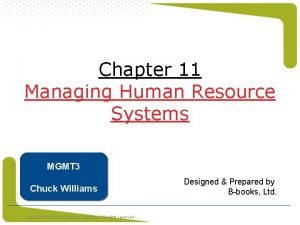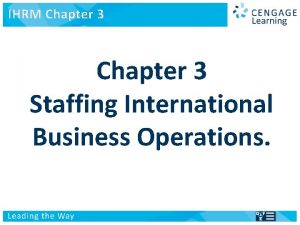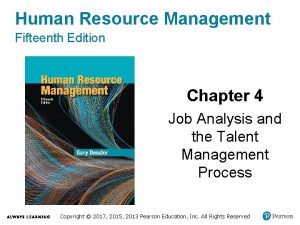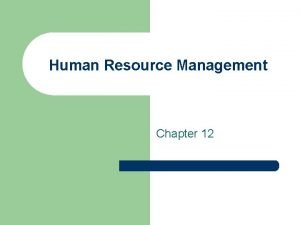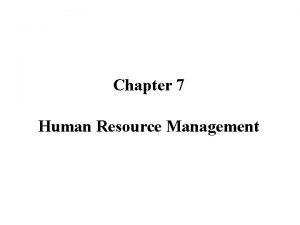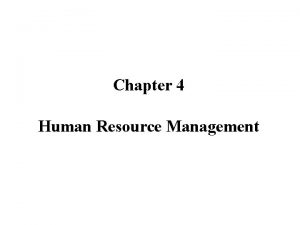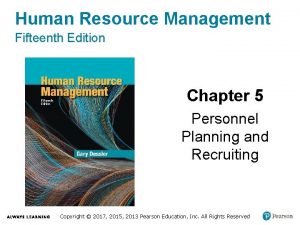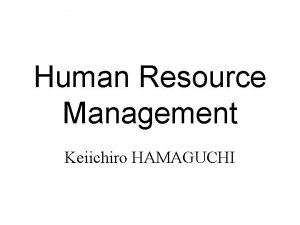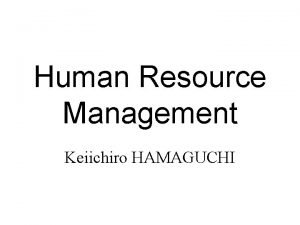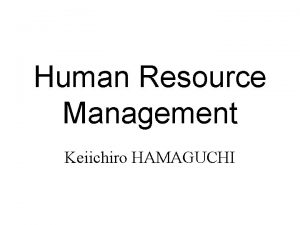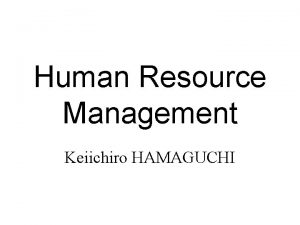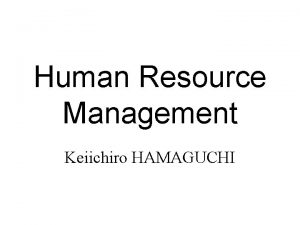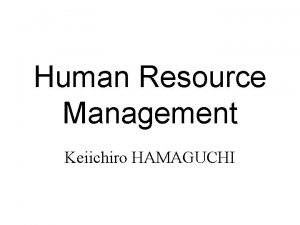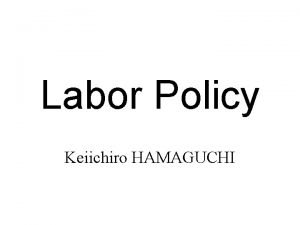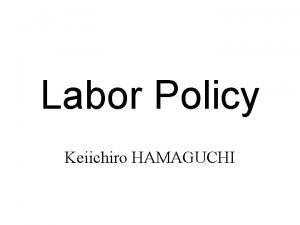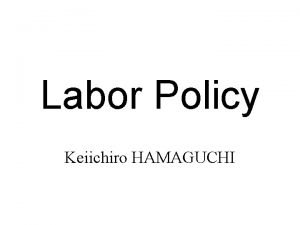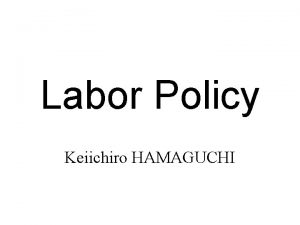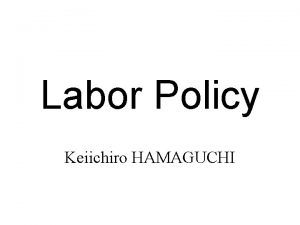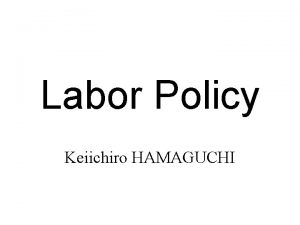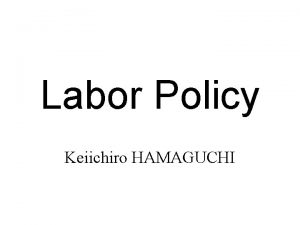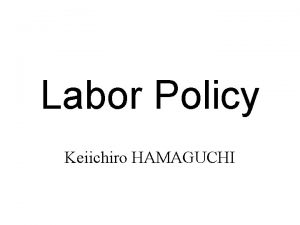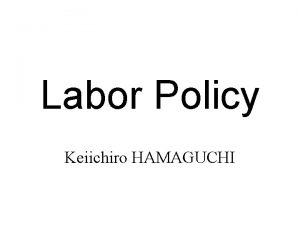Human Resource Management Keiichiro HAMAGUCHI Chapter 3 Legal


















- Slides: 18

Human Resource Management Keiichiro HAMAGUCHI

Chapter 3 Legal Aspects of Japanese Employment

Section 2 Recruiting and Hiring

(1) Hiring Practice in Japan • Personnel Division, not line managers, is responsible for entire hiring process of regular workers. • Recruiting starts before graduation and students are formally hired on April 1 st (regular hiring of new graduates). • Hiring via schools for high school graduates. • Hiring directly for university or college graduates.

• Japanese companies hire new graduates from the viewpoint of potential and future possibility, not for specific jobs (New graduate is blank slate). • Important is his/her personality (to get along with colleagues), not major field of study. • Mid-career hiring has been rather rare, but recently increasing. • Hiring throughout the year and hiring of secondary new graduates are introduced recently. • Non-regular workers are recruited at any time by line managers through simple procedure.

Hiring process of regular employees 1 Employer’s recruitment of workers ↓ 2 Applications for the job by the workers (Submission of the necessary documents) ↓ 3 Administration and taking of employment examinations Decision whether they have been passed ↓ 4 Notification of the tentative decision to hire Submission by the workers of their written undertaking and personal references ↓ 5 Diagnosis of the workers’ health ↓ 6 Ceremony marking the entry into the company (normally on 1 st April) Delivery of a written appointment to the job

(2) Freedom of Hiring and its Limitation • Employers have freedom of hiring. • They are not forced to conclude any contract (except for quota for the disabled). • They are free to recruit workers based on any criteria (except for sex and…). • Supreme court confirmed employers’ freedom of hiring based on belief (Mitsubishi Plastics case). • Strict regulation on dismissals affects this interpretation.

(a) Quota for the Disabled • Disabled Person’s Employment Promotion Law set quota for the disabled (1. 8% for private sector, 2. 1% for public sector). • The system does not compel the employer to conclude an employment contract. • It only collects levy from employers who fail to meet the quota.

(b) Equal Opportunity on Recruiting and Hiring (based on Sex) • Sex was allowed as an employment criteria until recently (Male-only or femaleonly recruitment was prevalent). • 1985 EEOL did not ban discriminatory recruitment (only imposed endeavor obligation). • 1997 EEOL prohibited discrimination except for positive action.

(c) Equal Opportunity on Recruiting and Hiring (based on Age) • Age has been the most important employment criteria until now. • Japanese human resources management relied on age criteria in many areas. • 2001 revised Employment Measures Law imposed endeavor obligation, which has lots of exemptions. • 2007 bill for revision of EML will prohibit age limit in recruiting and hiring in principle (under the discussion in the Diet).

(3)Transitional Period (a) Tentative Hiring Decision • College students begin job-seeking very early (more than half a year before graduation). • Companies give “tentative hiring decision”. • What is the legal character of “tentative hiring decision”? • Supreme Court held that employment contract has already established (Dai-Nippon Printing case). • Cancellation of tentative hiring decision needs “objective reasonableness and social acceptability. ”

(b) Probationary Period • New graduates are employed as probationary workers for 1 to 6 months. • Work rules usually state that company can dismiss probationary workers if found unqualified. • Supreme Court held that the criteria for dismissals of probationary workers is whether “objectively reasonable and socially acceptable. ”

(4) Freedom of Hiring and Restriction on Dismissals • Japanese law permit employers broad discretion on hiring. • But once employment relationship is formed, dismissal is strictly limited. • Restriction on dismissals is extended to probationary period or even period of tentative hiring decision. • Employer’s broad discretion on hiring is offset of restriction on dismissals. • If labor mobility increases in Japan, equality principle will become important.

(5) Career Development (a) In-house Vocational Training • Large manufacturing companies carried out in-house vocational training course from pre-war era. • Authorized joint vocational training schools run by SMEs also provided many core workers. • Due to rapid increase in higher education, the number of trainees decreased.

(b) OJT Plan Developed within the Firm • In-house training at Japanese firms is characterized by OJT. • New recruits are assigned gradually from easy tasks to difficult ones. • Individual workplaces are responsible for OJT. • 4 -5 years superior acts as an instructor and gives man-to-man guidance (Elder System). • Middle managers and supervisors are responsible for implementing OJT.

• Advantages of OJT: • Long-term employment outlook encourages workers to make selfdevelopment efforts through their work. • Work attitudes oriented to achieving maturity make them multi-skilled. • OJT instructors are trained in TWI. • Mutual cooperation among workers is fostered. • Production control system is compatible with OJT.

• However, OJT is not suitable for midcareer employees, who have already acquired skills outside the firm. • Companies begin to rethink the human resources development.

(c) Equal Treatment on Education and Training (based on sex) • 1997 revised EEOL clearly prohibited any discrimination against women in education and training except for positive actions.
 Time management human resources
Time management human resources Organized retail
Organized retail Function of personnel management
Function of personnel management Hrm chapter 2
Hrm chapter 2 Chapter 9 human resource management
Chapter 9 human resource management Chapter 11 human resource management
Chapter 11 human resource management Human resource management chapter 1
Human resource management chapter 1 Chapter 1 introduction to human resource management
Chapter 1 introduction to human resource management Human resource management 15th edition
Human resource management 15th edition Human resource management lecture chapter 1
Human resource management lecture chapter 1 Determinants of staffing choices
Determinants of staffing choices Human resource management chapter 4
Human resource management chapter 4 Chapter 12 human resource management
Chapter 12 human resource management Chapter 7 human resource management
Chapter 7 human resource management Chapter 7 human resource management
Chapter 7 human resource management Human resource management chapter 4
Human resource management chapter 4 Human side of project management
Human side of project management Replacement chart example
Replacement chart example Human resource management chapter 5
Human resource management chapter 5





